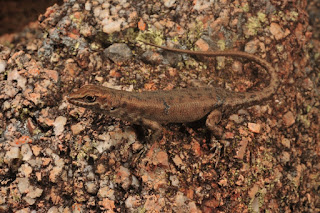While teaching, service and engagement are integral components of my job at JCU, so too is research. With that, comes supervision of students, who bring with them stimulating ideas for new projects.
My initial foray into trying to find a suitable study species was somewhat thwarted by teaching, distance to study site and an inability to find the little critters in the short time I had in the field. I was (and still am!) really curious about the mound-building behaviour shown by pebble mice Pseudomys sp., specifically the eastern pebble mouse P. patrius (Fig. 1), and would love to do a project on these guys. However, I had to put that on the backburner, and perhaps one day I’ll get a student super keen on finding out more about these animals.
 |
| Fig. 1. Eastern pebble mouse Pseudomys patrius (Photo: L. Hogan; https://wetlandinfo.ehp.qld.gov.au/wetlands/ecology/components/species/?pseudomys-patrius |
In 2013, I did some behavioural work on captive spectacled flying foxes Pteropus conspicillatus (Fig. 2) that were held at Tolga Bat Hospital. I ran some food preference experiments and also looked at their response to novel food. I also looked at drinking behaviour, and presented a poster at the Association for Tropical Biology and Conservation (ATBC) conference held in Cairns in 2014 (Fig. 3). As is always the way, I still have videos that have to be watched, data that need to be analysed and papers that need to be written!
 |
| Fig. 2. Spectacled flying fox Pteropus conspicillatus (Photo: T. Rymer) |
 |
| Fig. 3. Poster presented at ATBC Cairns 2014 |
 |
| Fig. 4. Fawn-footed mosaic-tailed rat Melomys cervinipes (Photo: D. Wilson) |
 |
| Fig. 6. Red-lipped stromb Strombus luhuanus |
In 2015, my new honours student, Ayla Turner, started exploring personality in M. cervinipes. She was lucky enough to receive funding from both the Skyrail Rainforest Foundation and the Wet Tropics Management Authority (WTMA). Ayla ran the mice through several behavioural mazes and conducted hormone analyses to determine personality types. We are currently in the process of preparing a paper for publication from her results. An undergraduate student, Stuart Biggs, also started a mini project looking at mate choice in M. cervinipes, which I hope to continue in the future. Both Ayla and Stuart presented posters of their preliminary findings at The Association for the Study of Animal Behaviour (ASAB) Behaviour2015 conference in Cairns (Fig. 7) and Stuart’s poster and speed talk provoked some interesting media attention. In addition, I presented some different aspect of Ayla’s work at the Australasian Society for the Study of Animal Behaviour conference in Katoomba, New South Wales, and the Australian Mammal Society conference in Alice Springs, Northern Territory in 2016. In 2015, I also co-supervised a Masters by coursework student, Anton Bordon, who looked at colour polymorphism of rock-dwelling skinks (Fig. 8) in Undara National Park.
 |
| Fig. 7. Ayla Turner (left) and Stuart Biggs (right) posters presented at Behaviour2015 Cairns 2015 |
 |
| Fig. 8. Outcrop rock-skin Libunascincus mundivensis (Photo: E. Vanderduys; http://calphotos.berkeley.edu/cgi/img_query?enlarge=0000+0000+1211+1323) |
There’s more to come so be sure to check out my next blog for more about my research activities. You can also read more in my publications, listed on my blog. You can also find me on ResearchGate or the James Cook University website.

0001.jpg)

No comments:
Post a Comment